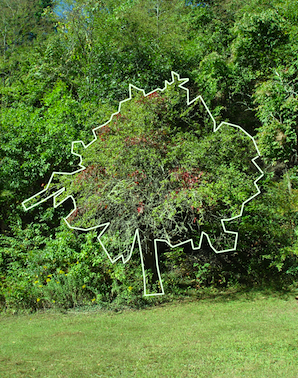
My wife’s great uncle had many apple trees on his North Carolina property. Though almost 90 years old, he walked his steep hillsides with me one morning pointing out the different varieties of apple by name and describing the distinctive flavor of each type.
Then he led me back over by the driveway at the base of a steep hill and pointed to a solitary tree I walked by without seein’ when I first arrived. He said it was the oldest apple tree on the mountainside planted by the original settlers on the old homestead. It’s kind of a sad thought to think that throughout the country there might be one last survivor of some old variety of apple that’s forgotten and unnoticed.
The first apple trees to arrive in the New World were planted by early American colonists in the 1600’s. The juice of these “winter bananas” or “melt-in-the-mouths” (as they were called) were a reliable alternative to drinking water, which in the Old World mindset was generally thought to be foul. But in addition to providing drink, apples were a reliable staple food that stored well through winter, fed livestock as well as people, and unlike money … “grew on trees” … literally.
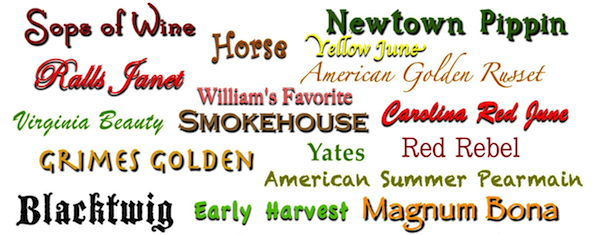
By the mid 1800’s, there were countless apple varieties with diverse characteristics slowly spreading throughout the growing nation. Other old varieties like Virginia Winesap, Roxbury Russet, and Old-fashioned Limbertwig were among several better suited to the warmer climates of the southern states.
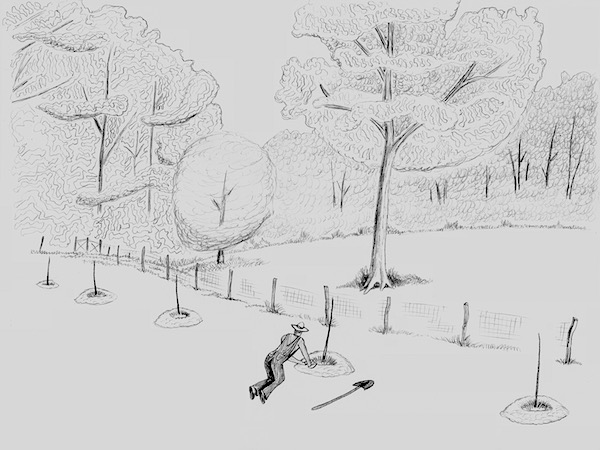

Back on my first farm in Tennessee, apples were grown in addition to the other fruits & vegetable gardens. I planted several old varieties of American heirloom apples anticipatin’ the harvest once they’d start bearing about 5 years down the road. And boy did they! …and kept right on bearing faithful every year. It’s one thing to study the history of America, but another thing entirely to plant and eat it. I reckon I don’t have to tell you we ate our share of apples: dried, liquefied, and pied.
Now that things on my new “apple-less” Arkansas farm are gettin’ along well, I’m anxious to make the situation a little more fruitful around here. And since an apple tree can begin bearing fruit at around 5 years or so, I’ll have to borrow and change the old Chinese proverb up a bit: “The best time to plant an apple tree is 5 years ago … the second-best time is today.”
If you’d been lookin’ in on me the day I planted these new trees, it might appear odd that they’re being planted in what are already woods. But these woods won’t be woods much longer ’cause I’m picturin’ a productive row of apple trees here, and apple trees need plenty of sunlight. This hillside has a gentle northward slope which is generally good for fruit trees. Seein’ that northward slopes are the last places to warm up in the spring, a fruit tree planted there would tend to have late comin’ blooms and might avoid a killin’ frost ever’ once in a while.
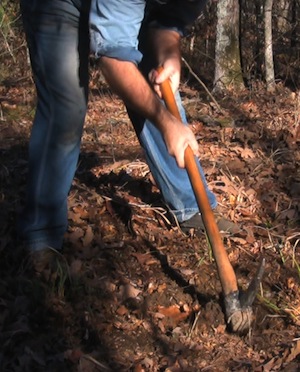

Had this been a heavily grassed area I might have prepared this ground a few months earlier so that the small, tender grass roots would have rotted by now. To ready the ground for the trees, I use the mattock which is one of my favorite tools for diggin’ … and the heavier one is, the better. The weight of the tool and gravity just about do the work for you, pulverizing and breakin’ up the dirt as it digs, and the pointy end can pry up rocks. With both the mattock and a shovel, I’m grubbin’ a hole at least a foot deep, and about a foot and a half wide to plant the trees in.
Although man a tree is planted in springtime, I prefer a fall plantin’, … especially in the warmer south. Planting leaf-shedding trees in autumn takes advantage of their dormant winter state “settlin’ ’em in” before a burst of root & leaf growth in the spring. This avoids the need for more frequent watering that follows a spring plantin’.
These trees are grafted onto rootstock that’s resistant to disease & drought and produces fruit quicker than a standard-sized tree. And it’s not called semi-DWARF for no reason. This type of rootstock limits growth to about 15′ tall & wide so I’ll space these trees about 15 feet apart. And if I ever put in another row of trees next to this one, I’ll set it 20 feet away, leaving me about 5 feet for walkin’ betwixt.
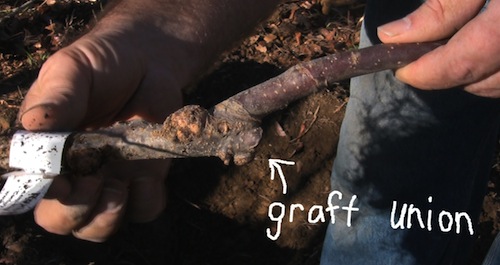
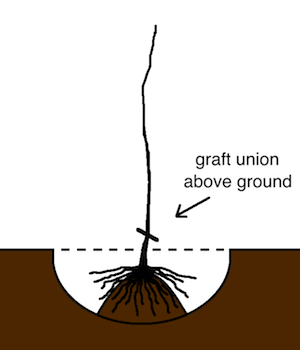
To ensure the qualities the rootstock will impart to the top of the tree, I need to keep from burying the graft union when the tree is planted. So a shovel full or two of dirt is added back to the bottom of the hole and loosely mounded up a little. This’ll give the tree a little seat to sit and spread its roots on and helps make sure the graft union will be situated above the ground.
One of these days I may just want a standard-sized tree. If so, I can just plant one of these semi-dwarf apples with the graft buried so roots will grow above it, space the trees about 20 feet apart, and build a taller ladder for pickin’. Although the wait for apples would take a few extra years, it would end up producing more apples and have a longer life span.
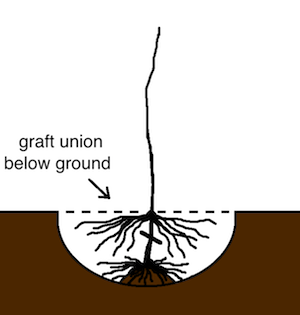

When it comes to the actual plantin’ of the tree, I gently make sure the roots are spread every which a way as they sit atop the little mound in the bottom of the hole, while tryin’ hard not to knock too much dirt off of ‘em. As I hold the trunk in place I pull the topsoil back in the hole, tuckin’ the roots in to a “good night’s sleep” (a long one, I hope). Without getting too carried away I tromp around the newly planted tree with my feet to get rid of any air pockets that might dry out the roots. I also cause the tree to lean slightly in the direction of the prevailing wind. This gives it just a smidgin’ extra help in defending against any unusually harsh or damaging winds.
Once the roots are all buried, I build up another little mound of dirt around the trees trunk that’ll sink down due to the loose soil once it’s watered. A large, ring-shaped mound is built up around the young tree that’ll catch the water and keep it from runnin’ away. As soon as they’re planted I like to water each tree by filling up the dirt ring at least twice, and maybe even again later that day. And if there’s normal rainfall in the autumn days to come, that usually does me for waterin’. As far as fertilizing is concerned, I won’t even think about putting some composted barnyard around these trees until they’ve sat through all four seasons of the year.
And now, I wait for apples.

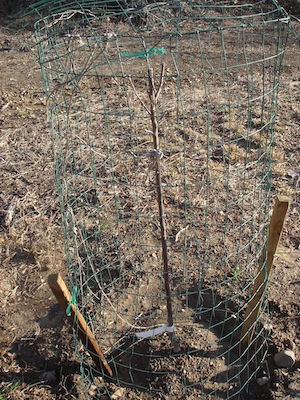
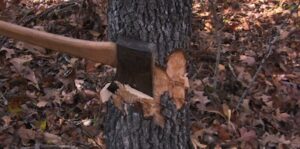
While I’m waitin’ I’ll think about protectin’ these vulnerable trees from deer that evidently think tender young apple branches make for an excellent dessert. Cylindrical wire cages fitted with tops will do the trick, along with a couple of well-driven stakes to keep them in place.
There’s also a need to protect these young apple whips from bigger trees that would threaten to steal their water and sunlight. Some trees I’ve already cut, and others I girdled with an axe by chipping off a ring of bark from each trees circumference. I tend to girdle trees I’m likely to use for tool handle stock or lumber, since it kills the tree but leaves it standing upright and out of my way till I’m ready for it. But I don’t leave ’em standin’ over a year, because felling a rotten tree is never recommended. When something like a standing, rotten tree earns the nick-name “widow-maker”, it shouldn’t be ignored.
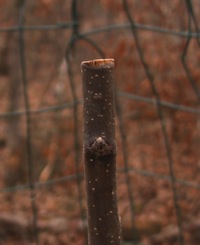
It won’t be long now until the little buds on these sticks swell and turn green come spring.
And now, if I may, I’d like to step back and add just a few more varied thoughts on apple tree plantin, heirloom varieties, and all such things.
To be honest, diggin’, plantin’, and carin’ proper for just these seven new trees of mine is no easy walk down the lane. The toil is good, though, knowing that the bulk of your labor investment goes in the front end, reaping the harvest down the road and for years into the future, as the Lord wills. Now that’s farmin’.
It’s also a good reminder of our humanity, and God’s sovereign grace and mercy. It was a fruit of some kind that Adam and Eve (real, live, first folks) sinned the first sin with; perhaps an apple … perhaps not. But even so, the rich diversity in flavor and usefulness, is a reminder to me of God’s common grace to ALL mankind. The rain falls on the just and the unjust, and into many lives over the centuries, an apple has fallen, too.
Given the endless list of varieties and historic significance of heirloom apple trees it was sure hard for me to narrow my choices down to only seven varieties. Although confident I’ll add more trees in years to come, these seven apple types are a good start to my own preferences and desires for apples. And that brings up an interesting point: What might a farmer or homesteader’s desires for apples be? Given the rich assortment of apple varieties and their diverse characteristics, the possibilities are left to one’s imagination to assemble in his or her own mind the best combinations of choices to fit the farmer or homesteader’s small orchard.
Here’s a list of some general apple characteristics one can ponder as the apple loving mind runs freely:
Ripening Time – Certain apple varieties may ripen as early as June, others as late as November, and the rest anywhere in betwixt. You might want all your trees to bear at once for the big cider pressin’, or all through the summer for continuous chompin’ down.

Keepers – This is how well an apple stores off the tree. Some do better than others, and that can be advantageous if apples are a big part of your diet, and you’re relying on ’em through the winter.
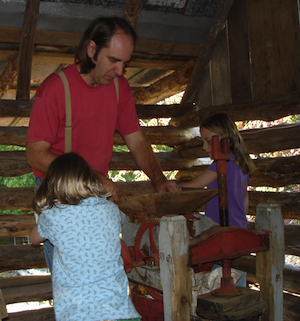
Cider – The key words here are “sweet” or “tart”. Some apples are sweet, some are tart, some are (strangely enough) a peculiar cross of both, and others are anywhere in between. It’s commonly thought that the best cider is usually pressed from a half and half combination of sweet apples and tart ones. But ultimately you’ll be the judge of what kind of cider suites your own taste buds.
Baking – These are the ones that hold their form best under the hot oven temperatures.
Drying – When I was a kid, mama would cut up apples kind of thin, spread them out on a metal pan, and dry them on top of the well house in the hot summer sun. It’s kind of like the jerky of the fruit world. Again, some varieties will suite you better for this
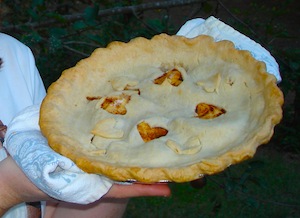
Apple Sauce or Apple Butter – These are the ones that cook down to a smooth pulp and don’t sacrifice their pleasing smell
Vinegar – Again, some are better for this than others
Out of Hand Eating – This is an easy one; pick and apple up, and eat it. Some of ’em will be your favorites for doin’ so. Incidentally, this was one of my favorite things about havin’ my old orchard so close to the garden. As an occasionally diversion from my normal garden toil, it was a pleasure of immense proportion to walk a few feet away and grab a quick snack from a tree.
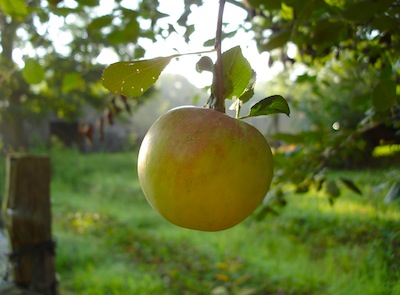
Appearance – Beauty is only skin deep … and especially with an apple; some apples are just downright pretty; others might taste nice, but just be so fairly homely lookin’ you feel kind of sorry for ’em … but it makes you love ’em more.
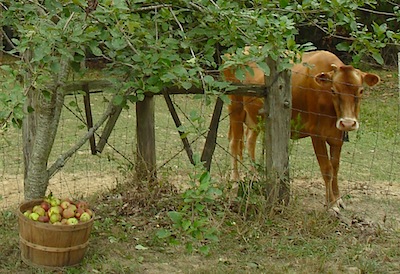
Livestock Feed – I’d be lookin’ for a type that kept well and produced late in the year. But I doubt a hog would hesitate with any single apple pitched in the trough.
Historic Significance – Sometimes it’s just plain fun to own a piece of history; …especially a livin’ one. And is there a better way to teach kids about this great country than by lettin’ ’em grow history themselves and then bite down on it?
One last word, and it’s one of thanks to two people.
First, to Lee Calhoun, who may be one of the most knowledgeable heirloom apple persons on the planet. I ordered my first heirloom trees from him, and he bent over backwards all those years ago to help me choose the varieties that were best suited. Mr. Calhoun is also the author of what’s probably the definitive work on southern heirloom apples, appropriately titled “Old Southern Apples”. Thanks, Mr. Calhoun, for your inspiration.
And secondly, to my new friend David C. Vernon, owner and operator of Century Farm Orchards in Reidsville, North Carolina, who provided many photos I used in the show. David follows in the footsteps of Lee Calhoun, and is a wealth of apple knowledge and apple enthusiasm. He’s also got some powerfully insightful apple tree information on his website ranging from videos to simple, easy-to-comprehend charts that lay out a multitude of apple varieties and their characteristics and uses. And if that doesn’t set your mouth to waterin’, you can order the apple from him, too. If you end up emailin’ or phonin’ David to order some apple trees, be sure and tell him “Pa Mac says ‘Hey!’”
articles and photos by Pa Mac, copyright 2013, Caddo Heritage Productions
Shared on:
From the Farm Blog Hop
Farmgirl Friday Blog Hop
Homestead Barn Hop
Clever Chicks Blog Hop
The Backyard Farming Connection
Tuesdays with a Twist
Down Home Blog Hop
Frugal Days, Sustainable Ways
The Thankful HomeAcre Hop
Simple Lives Thursday
